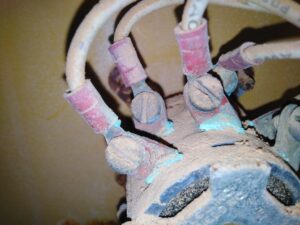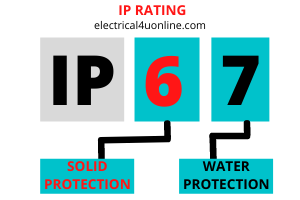Table of Contents
What does IP rating Mean?
An IP (Ingress Protection) rating is a standardized system that indicates how well an electrical or electronic device is protected against solid objects (like dust) and liquids (such as water). You’ll often see it written as “IP” followed by two numbers, for example, IP68.
Each number has a specific meaning:
First Digit – Protection Against Solid Objects:
- 0: No protection.
- 1: Protects against large objects (e.g., a hand, >50mm).
- 2: Protects against fingers or objects >12.5mm.
- 3: Protects against tools or wires >2.5mm.
- 4: Protects against small tools or wires >1mm.
- 5: Limited dust protection (dust may enter but won’t harm the device).
- 6: Fully dust-tight (no dust can enter).
Second Digit – Protection Against Liquids:
- 0: No protection.
- 1: Protects against vertically falling water drops.
- 2: Protects against water drops when tilted up to 15°.
- 3: Protects against water sprays at up to 60°.
- 4: Protects against water splashes from any direction.
- 5: Protects against low-pressure water jets.
- 6: Protects against powerful water jets and heavy seas.
- 7: Protects against temporary immersion in water (up to 1 meter for a short time).
- 8: Protects against continuous submersion in water beyond 1 meter (conditions set by the manufacturer).
IP rating is published by the International Electrotechnical Commission (IEC). The equivalent European standard is EN 60529.
Why IP Ratings Matter?

IP ratings are essential for determining how well electrical and electronic devices are protected against environmental factors like dust and water.
They’re commonly used for products such as:
- Smartphones
- Outdoor lighting fixtures
- Electrical enclosures
- Industrial machinery
For example, a device with an IP67 rating is:
- Dust-tight (first digit: 6)
- Water-resistant up to 1 meter deep for a limited time (second digit: 7)
I have written a complete guide about motor burn out causes and protection. You can find it here.
What is the meaning of 1st and 2nd x in IPxx?
An IP (Ingress Protection) rating is a two-digit code that specifies the level of protection an enclosure provides against solid objects and liquids.
- First Digit (Solid Protection): Indicates protection against solid particles like dust or objects.
- Second Digit (Liquid Protection): Defines resistance to water or moisture.
What Does “X” Represent in an IP Rating?
When an X appears in place of a digit, it means that no test was conducted for that specific protection level. For example:
- IP2X: The device is protected against solid objects larger than 12.5mm (like fingers), but no testing was done for water protection.
- IPX7: The device is tested for water immersion up to 1 meter but not for protection against solid objects.
- IP5X: The device offers dust protection (partial ingress) but hasn’t been tested for water resistance.
How to Interpret “X” in Practice
If a device has a rating of IPX7, it can withstand temporary immersion in water but may lack any protection against solid particles. Conversely, an IP5X rating ensures dust protection but leaves its liquid resistance untested.
Key Takeaway
The X in an IP rating simply indicates the absence of specific tests, not necessarily the absence of protection. Users should carefully consider their needs and ensure the equipment has been tested for the relevant protection levels.
IP Rating Tables

Rating tables are below with the description of the protection degree.
IP First Digit (Solid Particle Protection)
| IP Protection Degree | Digit |
| No protection |
0 |
| Protection against solid parts larger than 50mm diameter, such as the back of the hand. |
1 |
| Protection against solid parts >12.5mm in diameter, such as Fingers or similar tools and objects. |
2 |
| Protection against solid parts >2.5mm in diameter, such as Tools and wires. |
3 |
| Protection against solid parts >1mm diameter, such as screws and wires. |
4 |
|
5 |
Second Digit (liquid ingress protection)
| IP Protection Degree |
Digit |
| No protection |
0 |
| Protection against vertically falling water |
1 |
| Protection against water up to 15° from vertical |
2 |
| Protection against water spray up to 60° from vertical |
3 |
| Protection against water splashes from all directions |
4 |
| Protection against low-pressure jets from any angle |
5 |
| Protection against direct high-pressure jets |
6 |
| Protection against full immersion for up to 30 minutes at depths between 15 cm and 1 meter |
7 |
| Protection against extended immersion under higher pressure ingress |
8 |
| (K): Protection against high-pressure, high-temperature jet sprays of water |
9 |
Read also my article Motors in Wet Locations!
What is IP rating 3rd digit – IK impact protection rating?
The IK rating is an additional classification used in some IP-rated devices to indicate protection against mechanical impacts. It represents how well an enclosure can withstand impacts from external forces, ensuring that internal components remain safe and operational.
Importance of IK Ratings
Devices with IK ratings are crucial in environments where mechanical impact is a risk, such as:
- Construction sites
- Industrial facilities
- Public spaces
Using IK-rated products helps protect sensitive components, preventing equipment failures that could lead to safety hazards or costly downtime. For example, a single damaged component could halt an entire production line, making IK protection both a safety and economic necessity.
IK Rating Levels
The IK rating ranges from IK00 (no protection) to IK10 (highest protection). Here’s what each level means:
- IK00: No protection.
- IK01: Protects against a 0.25kg mass dropped from 56mm.
- IK02: Protects against a 0.25kg mass dropped from 80mm.
- IK03: Protects against a 0.2kg mass dropped from 140mm.
- IK04: Protects against a 0.25kg mass dropped from 200mm.
- IK05: Protects against a 0.25kg mass dropped from 280mm.
- IK06: Protects against a 0.25kg mass dropped from 400mm.
- IK07: Protects against a 0.5kg mass dropped from 400mm.
- IK08: Protects against a 1.7kg mass dropped from 300mm.
- IK09: Protects against a 5kg mass dropped from 200mm.
- IK10: Protects against a 5kg mass dropped from 400mm.
Choosing the Right IK Rating
When selecting equipment for environments prone to mechanical impacts, it’s essential to consider the IK rating. Higher IK ratings provide better protection, ensuring the device can withstand stronger impacts without compromising its functionality.
Which IP is waterproof LED lights?
LED lights come with different IP ratings to indicate their level of protection against water and dust. Here’s a breakdown of the most common IP ratings for LED lights and where they can be used:
IP68 LED Lights
- Fully waterproof and dust-tight
- Can be continuously submerged in water
- Ideal for outdoor use and underwater installations, such as pools, fountains, and aquariums.
IP67 LED Lights
- Waterproof but only for temporary immersion (up to 1 meter for a limited time).
- Suitable for outdoor use, like garden lighting or areas exposed to heavy rain, but not recommended for long-term underwater use.
IP65 LED Lights
- Splashproof and dustproof
- Can handle jets of water from any direction but cannot be submerged.
- Perfect for bathrooms, kitchens, and outdoor lighting under covered areas.
IPx7 LED Lights
- Can be submerged in water up to 1 meter for short periods.
- Suitable for outdoor installations in areas prone to temporary flooding or heavy rain.
IP33 LED Lights
- Minimal protection against water and dust.
- Best for indoor use in areas with no risk of water splashes or significant dust, such as living rooms and offices.
Key Takeaway
For fully waterproof LED lights, choose IP68 or IP67, depending on whether continuous immersion is required. For areas exposed to splashes or jets of water, IP65 lights are ideal. Always match the IP rating to the environment to ensure durability and safety.
Don’t Leave Empty-Handed!
Install my Free Android App on Google Play:
Electrical Cables Most Common Tables “Cables Tables”
And, my Electrical Calculations App “Fast Electrical Calculator”
Discover more great content by subscribing to My channel
Looking to stay ahead of the game in the world of electrical engineering? Subscribe to my YouTube channel and gain access to exclusive content you won’t find anywhere else!
The staff I recommend
(Amazon Affiliate Links to products I believe are high quality):
- Economy 120 Volt/60Hz AC Power Source – Step-Down Voltage & Frequency Converters 1800W
- UNI-T Digital Multimeter Tester UT139C
- 50-Amp Extension Cord for RV “100ft”
- Voltage Stabilizer 110/220v
- Hair Dryer “best selling“
- TOSHIBA EM131A5C-BS Countertop Microwave Ovens
Disclaimer: This contains affiliate links to Amazon products. I may earn a commission for purchases made through these links.
